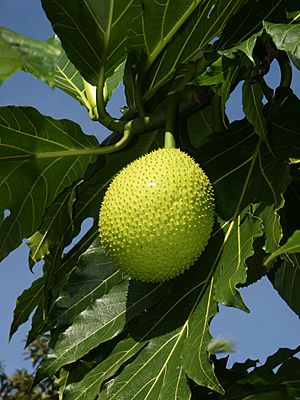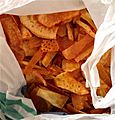Breadfruit facts for kids
Quick facts for kids Breadfruit |
|
|---|---|
 |
|
| Breadfruit at Tortuguero, Costa Rica | |
| Scientific classification | |
| Kingdom: | |
| (unranked): | |
| (unranked): | |
| Order: | |
| Family: | |
| Genus: |
Artocarpus
|
| Binomial name | |
| Artocarpus altilis |
|
Breadfruit is a cool tree that grows in warm, sunny places around the world. It's part of the mulberry family, and it's called "evergreen" because it keeps its leaves all year long! This amazing tree can grow super tall, sometimes up to 20 metres (66 ft) (that's about 65 feet!).
The breadfruit itself is the fruit of this tree. It's packed with starch, a bit like potatoes. People often grind it into flour to make tasty baked goods. You can find breadfruit trees growing in Asia, Central and South America, and the Caribbean.
Contents
History of Breadfruit
How Breadfruit Spread Across the Pacific
Long, long ago, about 3,500 years ago, people who were ancestors of today's Polynesians discovered breadfruit trees. They found them growing in the area of northwest New Guinea. These people had brought rice farming with them from Taiwan. But when they saw how useful breadfruit was, they started growing it instead of rice.
As these ancient travelers explored the Pacific Ocean, they took breadfruit trees with them. They planted them on almost every island they settled. The only places too cold for breadfruit were Easter Island and New Zealand. Later, other groups helped spread the plant west and north into coastal parts of Southeast Asia.
Breadfruit and the Mutiny on the Bounty
Breadfruit trees even played a big part in a famous historical event: the Mutiny on the Bounty. In 1787, a British ship called the Bounty was sent on a special mission. Its captain, William Bligh, was ordered to collect many breadfruit trees from Tahiti. The plan was to take them to the Caribbean.
The idea was that breadfruit would be a cheap and easy food source for people working on large farms, especially those growing sugarcane. This was one of the first times a government tried to move an important plant to a new part of the world.
However, the first trip didn't go as planned. The sailors on the Bounty didn't understand why their precious drinking water was being used for plants. They became unhappy and eventually threw the plants overboard, leading to the famous mutiny.
Breadfruit's Journey to the Caribbean
Even after the mutiny, Captain Bligh didn't give up. He managed to ship the breadfruit trees on a second voyage. When he finally arrived in the Caribbean, he faced a new challenge. Many of the people there were used to eating cereals and didn't want to try breadfruit as their main food.
Despite this, Bligh was recognized for his efforts. He even received a medal from The Royal Society. While breadfruit wasn't fully accepted everywhere, it did become an important part of the food in places like Puerto Rico.
Images for kids
-
Breadfruit (kolo) slices to be used for cooking in Filipino cuisine
-
A breadfruit tree in Honolulu, Hawaii
-
Breadfruit in Mangalore
-
Breadfruit in Kasaragod
-
Breadfruit, named and described in Characteres generum plantarum (1776)
-
A polished basalt breadfruit pounder
See also
 In Spanish: Árbol de pan para niños
In Spanish: Árbol de pan para niños












